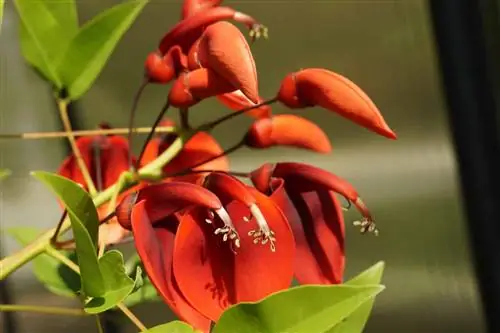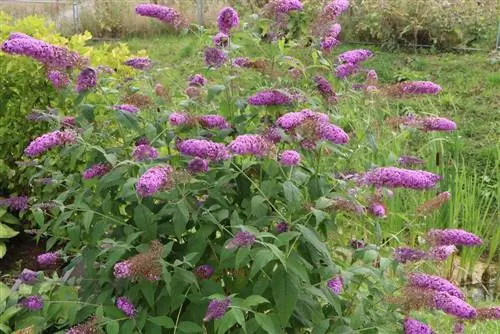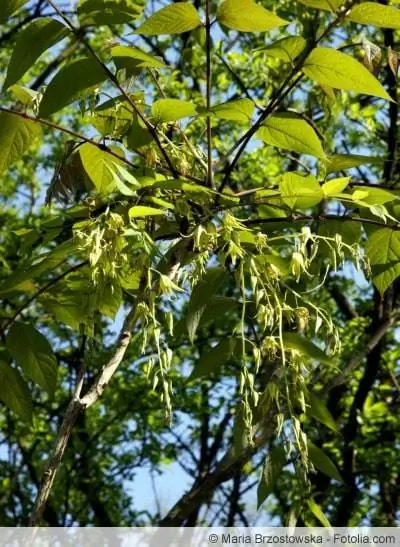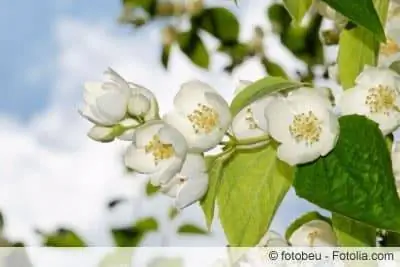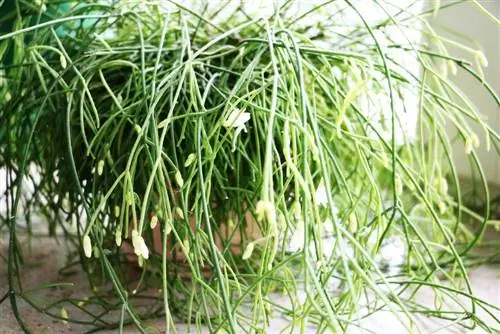- Author admin [email protected].
- Public 2023-12-17 03:39.
- Last modified 2025-06-01 06:48.
They were probably introduced to Europe by the Spanish. In the temperate zones of Central Europe, the coral bush is cultivated as a container plant because it is not hardy.
Properties of coral bush
The coral bush forms a tree-like trunk that becomes gnarled over the years and creates deep grooves in the bark. Its appearance is reminiscent of a vine. Every year it produces strong, long shoots with green foliage. At the ends, clusters of up to 40 cm long with bright red butterfly flowers form, from which the plant also owes its name.
- Erythrina crista-galli translated into German means “red cockscomb”.
- The eye-catching exotic can grow up to 1.50 m tall in a pot
- and blooms from June to September. It forms strong spines on its branches.
Location and overwintering of the coral bush
- The coral bush likes it very sunny. However, the heat should not build up.
- A sunny spot where there is a slight breeze is ideal.
- The potted plant can be placed on the terrace from May, as soon as frost is no longer expected.
The coral bush can tolerate light frost down to -5 °C. At the end of September or a little later it should still be moved to a cool and dark place in the house. It can be kept in a winter garden all year round. After the flowering period, the bush gradually loses its leaves and the shoots die. This is a completely natural process that cannot and should not be stopped by additional watering. This means that it doesn't need any light in winter and can easily be kept in the basement. However, it must not dry out completely. The soil should be kept slightly moist. Before the shrub comes back onto the terrace, you should put it in a bright place in the apartment from March or April to encourage it to grow. When it comes outdoors, it can be placed in the shade for a few days to get used to it to avoid burns on the leaves.

Watering and fertilizing the coral bush
As soon as the growth phase begins, the coral bush needs water regularly, in a moderate amount at the beginning, but even more as it grows. On hot summer days it may also be necessary to provide him with water in the morning and evening.
- From September, the amount of water can be gradually reduced.
- In winter quarters you should water very little, but make sure that the soil does not dry out completely.
- From mid-April you should add a portion of liquid complete fertilizer to the irrigation water every 7-10 days.
- Alternatively, the need for nutrients can also be met with slow-release fertilizer.
- The first dose is given at the beginning of April and should be refreshed again at the beginning of July.
Cut Erythrina crista-galli
In autumn, the shoots of Erythrina crista-galli begin to die and dry up. You should just let that happen. As soon as new shoots begin to grow from the sleeping eyes on the trunk and trunk branches in spring, any old shoots that are still present should be cut back. The flowers arise on the new shoots. The bush can still be thinned out until the end of May to give the crown a specific shape. Then you should let it grow. If you regularly remove wilted inflorescences from time to time, the shrub will be stimulated to produce more new inflorescences.
Repot coral bush
The coral bush should be repotted every two to four years. The best time for this is the beginning of May, when the bush moves outside. When repotting, it is good for the plant if the peripheral roots are shortened slightly. This encourages the roots to branch out more, which means they grow better in the new soil. You should only use pots or containers that have a hole in the bottom so that excess water can drain away easily.
Soil / Substrate
- High-quality potting soil that stores water and nutrients well is suitable for planting Erythrina crista-galli.
- It should contain coarse grains (gravel, lava grit, perlite, etc.) which ensure that the soil remains loose and does not become waterlogged.
- Caution: The proportion of peat should not be too large.
Creation / Propagation
The Erythrina crista-galli can be grown from seeds or propagated from cuttings. Growing from seeds indoors can be done all year round. To do this, let the large, bean-like seeds soak in lukewarm water overnight and place them 1 cm deep in potting soil the next day. At a temperature of 20 - 25 °C it takes 2 - 4 weeks until the seedlings sprout. After 5 - 8 weeks the small plants can be transplanted. By the way, the seeds are poisonous, so they should be kept out of the hands of small children. When grown from seeds, it takes about four years for the plant to bloom for the first time. When propagated from cuttings, the first flowers form earlier. The best time for this is in April, shortly after the bush has recently sprouted. Cut off a strong shoot with three leaves a few centimeters below the node and place it in a small pot with loose, moist soil to root. The pot needs a bright and evenly warm location. High humidity promotes the growth process.
Diseases and pests
Since the coral bush sheds most of its shoots every year, pests can hardly establish themselves in the long term. When it is extremely hot in summer, it is often attacked by spider mites. Aphids can also appear from time to time. If you notice the infestation early, it is usually enough to spray the entire plant several times with water from the garden hose. If you have only noticed the pest infestation late, it may also be necessary to treat the bush with a plant protection spray.

